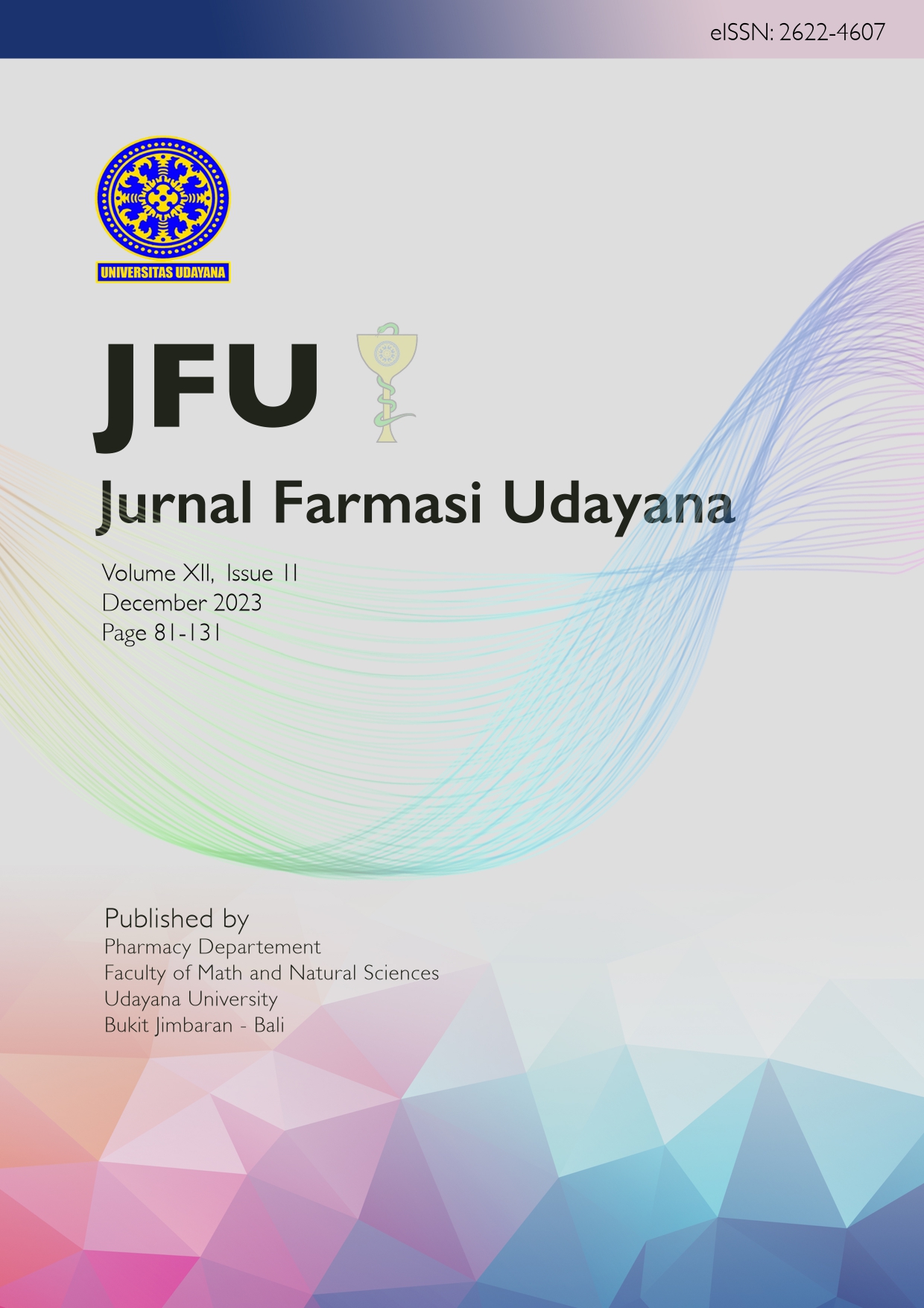Review: Etnobotani, Toksisitas, Fitokimia, dan Aktivitas Biologi Dari Tumbuhan Renda (Carissa carandas L)
Abstract
Renda (Carissa carandas L.) is a plant in the Apocynaceae family with dichotomous branches and milky sap. The plant bears small, oval-shaped fruits that are green at first and turn reddish-purple as they ripen. This review aims to integrate the secondary metabolites and biological activities of Carissa carandas L while also providing the scientific evidence required for future research. Online and offline literature were used to review this article. Online literature is sourced from local and international journal publications from journal providers on the internet and from online literature in books and e-books. This article covers the ethnobotany, toxicity, secondary metabolite compounds, and biological activities reported through search engines such as Google Scholar, NCBI, PubMed, ScienceDirect, Research Gate, and Springer. Based on existing literature, Carissa carandas can help treat diabetes, hypertension, hepatoprotection, anticonvulsants, antimalarials, antioxidants, anthelmintics, diarrhea, and hyperlipidemia.
Downloads
References
Bapna S, Ramaiya M, Chowdhary A. Antimalarial Activity of Carissa carandas Linn. Against Plasmodium falciparum. J Antimicrob (Photon) 2013;128:246-50
Begum S, Syed SA, Siddiqui BS, Sattar SA, Choudhary MI (2013) Carandinol: First isohopane triterpene from the leaves of Carissa carandas L. and its cytotoxicity against cancer cell lines. Phytochemistry Letters 6: 91-95.
Bhaskar VH, Balakrishnan N (2009) Analgesic, Anti-inflammatory and Antipyretic Activities of Pergularia daemia and Carissa carandas. 17: 168-174.
Devmurari, V., Shivanand, P., Goyani, M.B., Vaghani, S. & Jivani, N.P. 2009. A review: Carissa congesta: Phytochemical constituents, traditional use and pharmacological properties. Pharmacognosy Reviews, 3(6): 375–377.
Dhar G, Akther S, Sultana A, May U, Islam MM, Dhali M, Sikdar D. (2017) Effect of Extraction Solvents on Phenolic Contents and Antioxidant Capacities of Artocarpus chaplasha and Carissa carandas Fruits from Bangladesh. Journal of Applied Biology and Biotechnology 5: 39-44.
Hati M, Jena BK, Kar S, Nayak AK (2014) Evaluation of Anti-inflammatory and Anti-pyretic Activity of Carissa carandas L. Leaf Extract in rats. Journal of Pharmaceutical, Chemical and Biological Sciences 1:18-25.
Inamullah SS, Rai J, Choudhary N, Sharma S (2013) A Review on Carissa carandas L. International Journal of Pharmacy and Natural Medicines 1: 63-70.
Itankar PR, Lokhande SJ, Verma PR, Arora SK, Sahu RA, Patil AT. Antidiabetic Potential of Unripe Carissa carandas Linn. Fruit Extract. Journal Ethnopharmacol (2011);135(2):430-3.
Khushbu V, Divya S, Gaurav K (2015) Antioxidant Activity and DNA Damage Inhibition in vitro by a Methanolic Extract of Carissa carandas (Apocynaceae) Leaves. Journal of Taibah University for Science 9: 34-40.
Maheshwari R, Sharma A, Verma D. Phyto-therapeutic Significance of Karaunda. Bull Environ Pharmacol Life Asian J Pharm Clin Res, Vol 8, Issue 3, (2015), 26-30
Mehmood MH, Anila N, Begum S, Syed SA, Siddiqui BS, Gilani AH. Pharmacological Basis for the Medicinal Use of Carissa carandas in Constipation and Diarrhea. J Ethnopharmacol (2014);153(2):359-67
Mishra CK, Sasmal D, Shrivastava B. An in vitro Evaluation of the Anthelmintic Activity of Unripe Fruits Extract of Carissa carandas Linn. Int J Drug Dev Res 2012;4(4):393-7.
Naim Z, Khan M, Nizami S. Isolation of a new Triterpenic Alcohol from of Carissa carandas. Pakistan Journal Science and Research 1985; 28: 378-381.
Pino JA., Marbot R., Vazquez C., Volatile flavor constituents of Karanda (Carissa carandas L.) Fruit. Journal of Essential Oil Research (2004); 16: 432-434.
Rajaram S, Ashvin G (2013) Comparative Studies of Phytochemical Screening of Carissa carandas L. Asian Journal of Plant Science and Research 3: 21-25.
Rusli, Z., Sari, B.L., Wardatun, S. & Aristyo, W. 2020. Skrining Toksisitas Akut Beberapa Fraksi Buah Karonda (Carissa carandas L.) pada Embrio Zebrafish (Danio rerio). Fitofarmaka Jurnal Ilmiah Farmasi, 10(1): 42–53.
Sarma A, Sarmah P, Kashyap D, Dutta S, Mahanta M (2015) Antioxidant Activity and Nutraceutical Property of the Fruits of an Ethno-Medicinal Plant: Carissa carandas L. found in Brahmaputra Valley Agro-Climatic Condition. Journal of Pharmaceutical Sciences and Research 7: 55-57.
Shamim S, Ahmad SI. Pharmacodynamic Study on Acute Hypotensive Activities of Carissa carandas Extract in Normal Rats. J Pharm Sci 2012;25(3):577-82.
Shrivastava, B., Kumar Mishra, C., Shrivastava B And, B., & Sasmal, D. (2013). Pharmaconostical Standarization and Phytochemical Identification Of Fruit and Root Of Carissa carandas LINN. Journal Pharmacy and Pharmaceutical Science.
Siddiqui S, Ghani U, Ali S, Usmani S, Begum S.. Triterpenoidal Constituents of the Leaves of Carissa carandas. Natural Product Research 2003; 31: 753-755. 20. Vegetable tannin recourses of Jammu and Kashmir. Bulletin of Regional Research Laboratory, Jammu 1963; 1: 136-141.
Singh A, Uppal GK (2015) A Review on Carissa carandas Phytochemistry, Ethno-Pharmacology, and Micropropagation as Conservation strategy. Asian Journal of Pharmaceutical and Clinical Research 8: 26-30.
Sumbul S, Ahmed SI (2012) Anti-hyperlipidemic Activity of Carissa carandas (Auct.) Leaves Extract in Egg Yolk Induced Hyperlipidemic Rats. Journal of Basic and Applied Sciences 8: 124-134.
Tesfaye, T. & Ravichadran, Y.D. 2018. Traditional Uses, Pharmacological Action and Phytochemical Analysis of Carissa carandas Linn.: A Review. Natural Products Chemistry & Research, 06(05): 1–20.
Virmani R, Virmani T, Singh C, Sorout G, Gupta J (2017) Review on Hidden Potential of Natural Herb Carissa carandas (Karonda). Research in Pharmacy and Health Sciences 3: 294-302.
Verma S, Chaudhary HS (2011) Effect of Carissa carandas Against Clinically Pathogenic Bacterial Strains. Journal of Pharmacy Research 4: 3769-3771.




